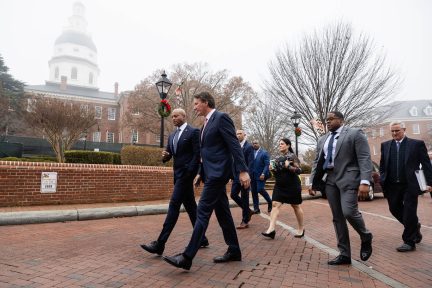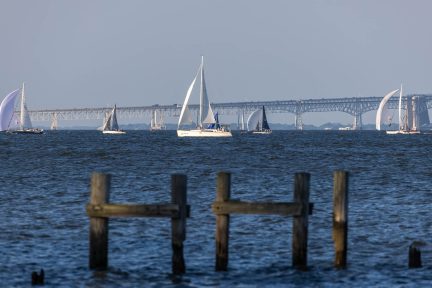Chesapeake Executive Council calls for increased support for farmers across the Watershed
At the annual meeting of the Chesapeake Executive Council, representatives from the six Chesapeake Bay watershed states, the District of Columbia, the Chesapeake Bay Commission and the Environmental Protection Agency (EPA) signed a directive in support of increasing technical assistance to the farmers of the Chesapeake Bay watershed.
“Maryland is fortunate to be home to countless natural assets, but for us none is more important than the Chesapeake Bay,” said Maryland Governor Larry Hogan. “Today’s meeting is a critical opportunity to review some of our successes, acknowledge our challenges and forge a path forward together with our regional partners that will help us to accomplish even more. I believe very strongly that if we embrace a spirit of bipartisan cooperation, together we can find real, common sense solutions to protect the Bay and preserve this national treasure for future generations.”
The Chesapeake Executive Council, established 35 years ago, is responsible for guiding the policy agenda for the Chesapeake Bay Program and setting conservation and restoration goals. Members include the governors of Delaware, Maryland, New York, Pennsylvania, Virginia and West Virginia, the Mayor of the District of Columbia, the Chair of the Chesapeake Bay Commission and the Administrator of the EPA on behalf of the federal government.
“Through the Chesapeake Bay Program, we are making significant progress reducing pollution and improving the health of the Bay, as demonstrated by the current record acreage of underwater grasses,” said acting EPA Administrator Andrew Wheeler. “Today, we signed a directive to assist farmers in conservation efforts, so we can work together to meet our pollution reduction goals and continue to improve the water quality of local streams and the Bay.”
The directive recognizes the crucial role that farmers play in the Chesapeake Bay watershed, while acknowledging the need for increased technical assistance to help the agricultural sector in meeting their pollutant reduction goals. The EPA recently released its evaluations of the progress each of the six watershed states and the District of Columbia are making toward meeting their pollutant reductions goals under the Chesapeake Bay Total Maximum Daily Load (Bay TMDL). While considerable progress has been made in reducing the pollution flowing into the Chesapeake Bay since the Bay TMDL was first put into place, the agriculture sector is identified as one in which additional work is needed. The Bay TMDL calls for all pollution control measures needed to fully restore the Bay and its tidal rivers to be in place by 2025.
“Our farmers are strong stewards of the land and their contributions to improving water quality have been immense,” said Senator Frank Wagner, Chairman of the Chesapeake Bay Commission. “But to achieve clean water throughout the Bay watershed, we need to do even more. The directive signed by the Executive Committee today helps ensure farmers will have the assistance they need to finish the job. Last year, the Chesapeake Bay Commission issued a report focused on the technical assistance farmers need to improve both water quality and their bottom-line. The Executive Committee of the Chesapeake Bay Program – the political leadership of the watershed - have now adopted the report’s core recommendations. The farmers are willing to do the job. It’s our job to get them the help they need.”
In June 2014, the Executive Council signed the Chesapeake Bay Watershed Agreement, with the vision of fostering an environmentally and economically sustainable watershed with clean water, abundant life, conserved lands and access to the water, a vibrant cultural heritage, and a diversity of engaged citizens and stakeholders. As part of the Watershed Agreement, Chesapeake Bay Program partners adopted for the first time a goal to increase the number and diversity of people who support and carry out conservation and restoration work. At today’s meeting, Governor Hogan announced that the Bay Program is setting new goals for increasing diversity by 2025. These include increasing both the percentage of people of color in the Chesapeake Bay Program to 25 percent and the percentage of people of color in leadership positions to 15 percent.
“This renewed commitment to enhancing diversity and inclusivity will help us build cleaner, healthier waterways for the entire region,” said District of Columbia Mayor Muriel Bowser. “To restore our shared waterways and build a more resilient Washington, DC, the District is proud to commit to more rigorous pollution reduction goals that account for the impact of climate change on water quality.”
The Executive Council elected Maryland Governor Larry Hogan as Chair for a second term and heard from the Chesapeake Bay Program’s three Advisory Committees, who represent citizens, local governments and the scientific and technical interests from across the watershed.
“The Chesapeake Bay ecosystem thrives on diversity and so does the strength of our collective restoration efforts, said Paula Jasinski, chair of the Chesapeake Bay Program’s Citizens Advisory Committee. “The Citizens Advisory Committee applauds this new goal to bring new voices to the table as we work towards providing clean air and clean water for everyone in the watershed.”
Quotes
"My administration is committed to the sustainability of agriculture in Pennsylvania. Our farmers are working hard on local water quality, and we’re seeing positive outcomes from our partnerships and initiatives. Federal resources remain a vital component. In forging all possible means for continued progress, we look to realize opportunities in the proposed Farm Bill for increased Conservation Reserve Enhancement Program enrollment, additional funding for the Environmental Quality Incentives Program, and funds dedicated to Chesapeake Bay initiatives. Federal funding will amplify our investments and support our commitment to improving water quality. Pennsylvania has unprecedented momentum in its watershed work. The timing couldn't be better to bolster farmers' efforts."
- Tom Wolf, Governor, Commonwealth of Pennsylvania
"Delaware is invested in Chesapeake Bay restoration efforts and remains a committed partner in the Chesapeake Bay Program where all jurisdictions can share successes, challenges and opportunities to move forward. Delaware has made progress in reducing nutrients, yet we acknowledge that there is more work to be done. We are committed to working with our local and federal partners to achieve success in the future."
- John Carney, Governor, State of Delaware
"Growing up on Virginia's Eastern Shore, I witnessed the decline of the Bay, and I am personally encouraged by the clear evidence of an improving Bay. Bipartisan collaboration, such as the work of the Chesapeake Executive Council, will be essential to build on our past successes and continue progress through new and tougher challenges. Through our actions today, the Executive Council spotlights the critical need for workforce development. My administration is committed to building and sustaining the agricultural technical expertise necessary to achieve our clean water goals."
- Ralph Northam, Governor, Commonwealth of Virginia



